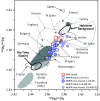Pan-European atmospheric lead pollution, enhanced blood lead levels, and cognitive decline from Roman-era mining and smelting
- PMID: 39761387
- PMCID: PMC11760502
- DOI: 10.1073/pnas.2419630121
Pan-European atmospheric lead pollution, enhanced blood lead levels, and cognitive decline from Roman-era mining and smelting
Abstract
Ancient texts and archaeological evidence indicate substantial lead exposure during antiquity that potentially impacted human health. Although lead exposure routes were many and included the use of glazed tablewares, paints, cosmetics, and even intentional ingestion, the most significant for the nonelite, rural majority of the population may have been through background air pollution from mining and smelting of silver and lead ores that underpinned the Roman economy. Here, we determined potential health effects of this air pollution using Arctic ice core measurements of Roman-era lead pollution, atmospheric modeling, and modern epidemiology-based relationships between air concentrations, blood lead levels (BLLs), and cognitive decline. Findings suggest air lead concentrations exceeded 150 ng/m3 near metallurgical emission sources, with average enhancements of >1.0 ng/m3 over Europe during the Pax Romana apogee of the Roman Empire. The result was blood lead enhancements in young children of about 2.4 µg/dl above an estimated Neolithic background of 1.0 µg/dl, leading to widespread cognitive decline including a 2.5-to-3 point reduction in intelligence quotient throughout the Roman Empire.
Keywords: human health; intelligence quotient; lead poisoning; lead pollution; roman antiquity.
Conflict of interest statement
Competing interests statement:The authors declare no competing interest.
Figures



References
-
- Giller K. E., Witter E., McGrath S. P., Toxicity of heavy metals to microorganisms and microbial processes in agricultural soils: A review. Soil Biol. Biochem. 30, 1389–1414 (1998).
-
- Bellinger D. C., Very low lead exposures and children’s neurodevelopment. Curr. Opin. Pediatr. 20, 172–177 (2008). - PubMed
Publication types
MeSH terms
Substances
LinkOut - more resources
Full Text Sources

